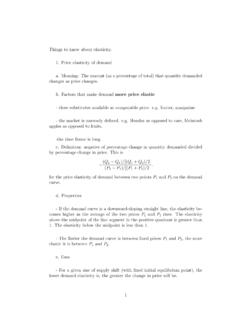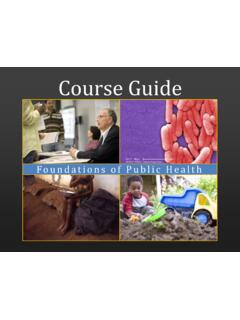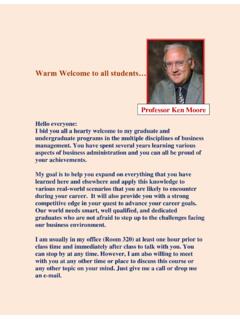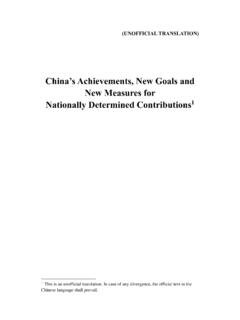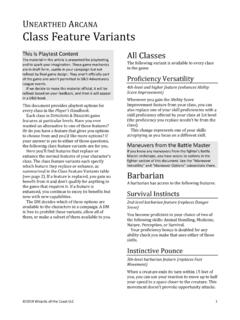Transcription of COMPETITIVE ADVANTAGE - University at Albany, SUNY
1 COMPETITIVE ADVANTAGE Creating and Sustaining Superior Peifonnance Michael E. Porter 1&1 THE FREE PRESS A Division of A1acmillan, Inc. NEW YORK Maxwell Macmillan Canada TORONTO Maxwell Macmillan International NEW YORK OXFORD SINGAPORE SYDNEY Copyright 1985 by Michael E. Porter All rights reserved. No part of this book may be reproduced or transmitted in any form or by any means, electronic or mechanical, including photocopying, recording, or by any information storage and retrieval system, without permission in writing from Ihe Publisher. The Free Press A Division of Macmillan, Inc. 866 Third Avenue, New York, 10022 Maxwell Macmillan Canada, Inc. 1200 Eg!inton Avenue East Suite 200 Don Mills, Onlario M3C 3~I Macmillan, Inc. is part of the Maxwell Communication Group of Companies. Printed in the United States of America printing number 20 21 22 23 24 25 26 27 28 29 30 Library of Congress Cataloging in Publication Data Porter, Michael E.
2 COMPETITIVE ADVANTAGE . Bibliography: p. Includes index. L Competition. 2. Industrial management. I. Title. 1985 658 83-49518 ISBN 0-02-925090-0 1 COMPETITIVE Strategy: The Core Concepts Competition is at the core of the success or failure of firms. Competition determines the appropriateness of a firm's activities that can contribute to its performance, such as innovations, a cohesive culture, or good implementation. COMPETITIVE strategy is the search for a favorable COMPETITIVE position in an industry, the fundamental arena in which competition occurs. COMPETITIVE strategy aims to establish a profitable and sustainable position against the forces that determine industry competition. Two central questions underlie the choice of COMPETITIVE strategy. The first is the attractiveness of industries for long-term profitability and the factors that determine it. Not all industries offer equal opportu nities for sustained profitability, and the inherent profitabilit~l of its industry is one essential ingredient in determining the profitability of a firm.
3 The second central question in COMPETITIVE strategy is the determinants of relative COMPETITIVE position within an industry. In most industries, somc firms arc much more profitable than others, 2 COMPETITIVE ADVANTAGE regardless of what the average profitability of the industry may be. Neither question is sufficient by itself to guide the choice of com petitive strategy. A firm in a very attractive industry may still not earn attractive profits if it has 'chosen a poor COMPETITIVE position. Conversely, a firm in an excellent COMPETITIVE position may be in such a poor industry that it is not very profitable, and further efforts to enhance its position will be of little Both questions are dynamic; industry attractiveness and COMPETITIVE position change. In dustries become more or less attractive over time, and COMPETITIVE position reflects an unending battle among competitors. Even long periods of stability can be abruptly ended by COMPETITIVE mOves.
4 Both industry attractiveness and COMPETITIVE position can be shaped by a firm. and this is what makes the choice of competitivo strategy both challenging and exciting. While industry attractiveness is partly a reflection of factors over which a firm has little influence, COMPETITIVE strategy has considerable power to make an industry more or less attractive. At the same time, a firm can clearly improve or erode its position within an industry through its choice of strategy. COMPETITIVE strategy, then, not only responds to the environment but also attempts to shape that environment in a firm's favor. These two central questions in COMPETITIVE strategy have been at the core of my research. My book COMPETITIVE Strategy: Techniques for Analyzing Industries and Competitors presents an analytical frame work for understanding industries and competitors, and formulating an overall COMPETITIVE strategy. It describes the five COMPETITIVE forces that determine the attractiveness of an industry and their underlying causes, as well as how these forces change over time and can be influ enced through strategy.
5 It identifies three broad generic strategies for achieving COMPETITIVE ADVANTAGE . It also shows how to analyze competi tors and to predict and influence their behavior, and how to map competitors into strategic groups and assess the most attractive posi tions in an industry. It then goes on to apply the framework to a range of important types of industry environments that I term struc tural settings, including fragmented industries, emerging industries, industries undergoing a transition to maturity, declining industries, IMany strategic planning concepts have ignored industry attractiveness and stressed the pursuit of market share, often a recipe for pyrrhic victories. The winner in a fight for share in an unattractive industry may not be profitable, and the fight itself may make industry structure worse or erode the winner's profitability. Other planning concepts associate stalemates. or inability to get ahead of competitors, with unattrac tive profits.
6 In fact, stalemates can be quite profitable in attractive industries, 3 COMPETITIVE Stracegy: The Core Concepts and global industries. Finally, the book examines the important strate gic decisions that occur in the context of an industry, including vertical integration, capacity expansion, and entry. This book takes the framework in COMPETITIVE Strategy as a start ing point. The central theme of this book is how a firm can actually create and sustain a COMPETITIVE ADVANTAGE in its industry-how it can implement the broad generic strategies. My aim is to build a bridge between strategy and implementation, rather than treat these two subjects independently or consider implementation scarcely at atl as has been characteristic of much previous research in the field. COMPETITIVE ADVANTAGE grows fundamentally out of value a firm is able to create for its buyers that exceeds the firm's cost of creating it. Value is what buyers are willing to pay, and superior value stems from offering lower prices than competitors for equivalent benefits or providing unique benefits that more than offset a higher price.
7 There are two basic types of COMPETITIVE ADVANTAGE : cost leadership and differentiation. This book describes how a firm can gain a cost ADVANTAGE or how it can differentiate itself. It describes how the choice of COMPETITIVE scope, or the range of a firm's activities, can play a powerful role in determining COMPETITIVE ADVANTAGE . Finally, it trans lates these concepts, combined with those in my earlier book, into overall implications for offensive and defensive COMPETITIVE strategy, including the role of uncertainty in influencing strategic choices. This book considers not only COMPETITIVE strategy in an individual industry but also corporate strategy for the diversified firm. COMPETITIVE advan tage in one industry can be strongly enhanced by interrelationships with business units competing in related industries, if these interrela tionships can actually be achieved. Interrelationships among business units are the principal means by which a diversified firm creates value, and thus provide the underpinnings for corporate strategy.
8 I will de scribe how interrelationships among business units can be identified and translated into a corporate strategy, as well as how interrelation ships can be achieved in practice despite the organizational impedi ments to doing so that are present in many diversified firms. Though the emphases of this book and my earlier book are differ ent, they are strongly complementary. The emphasis of COMPETITIVE Strategy is on industry structure and competitor analysis in a variety of industry environments, though it contains many implications for COMPETITIVE ADVANTAGE . This book begins by assuming an understand ing of industry structure and competitor behavior, and is preoccupied with how to translate that understanding into a COMPETITIVE ADVANTAGE . 4 COMPETITIVE ADVANTAGE Actions to create COMPETITIVE ADVANTAGE often have important conse quences for industry structure and COMPETITIVE reaction, however, and thus I will return to these subjects frequently.
9 This book can be read independently of COMPETITIVE Strategy, but its power to aid practitioners in formulating strategy is diminished if the reader is not familiar with the core concepts presented in the earlier book. In this chapter, I will describe and elaborate on some of those concepts. The discussion of the core concepts will also provide a good means of introducing the concepts and techniques in this book. In the process, I will address some of the most important questions that arise in applying the core concepts in practice. Thus even readers familiar with my earlier book may find the review of interest. The Structural Analysis of Industries The first fundamental determinant ofa firm's profitability is indus try attractiveness. COMPETITIVE strategy must grow out of a sophisti cated understanding of the rules of competition that determine an industry's attractiveness. The ultimate aim of COMPETITIVE strategy is to cope with and, ideally, to change those rules in the firm's favor.
10 In any industry, whether it is domestic or international or produces a product or a service,2 the rules of competition are embodied in five COMPETITIVE forces: the entry of new competitors, the threat of substitutes. the bargaining power of buyers, the bargaining power of suppliers, and the rivalry among the existing competitors (see Figure 1-1). The collective strength of these five COMPETITIVE forces determines the ability of firms in an industry to earn, on average, rates of return on investment in excess of the cost of capitaL The strength of the five forces varies from industry to industry, and can change as an industry evolves. The result is that all industries are not alike from the standpoint of inherent profitability. In industries where the five forces are favorable, such as pharmaceuticals, soft drinks, and data base publishing, many competitors earn attractive returns. But in in dustries where pressure from one or more of the forces is intense, such as rubber, steel, and video games, few firms command attractive 2 These concepts apply equalLy to products and services.
